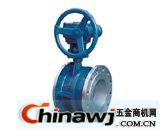Two-way pressure valve structure: Main shaft by the wedge, the valve body, disc, stem, wedges on the shaft, filler, bonnet, packing gland and the guide block and so on. The working principle is that, in the open state, the valve stem rotates to the right, and the guide block guides the valve stem to drive the butterfly plate to rotate to the right by 90°, so that the sealing surface of the butterfly plate and the sealing surface of the valve body are in parallel position, and the valve stem continues to rotate rightward, the guiding block Guide the valve stem to move downward, push the upper and lower wedges, so that the wedge wedge surface pushes the butterfly plate and the valve body sealing surface to contact, the butterfly valve closes to achieve sealing; in the closed state, the valve stem is left-handed, and the guiding block guides the valve stem to move upward Pushing the upper and lower wedges to move upwards, the wedge wedge surface drives the butterfly plate to translate, the two-way pressure butterfly valve butterfly sealing surface and the valve body sealing surface are separated, and after the butterfly plate moves a certain eccentric distance, the valve stem continues to rotate left, the guiding block The valve stem is guided to rotate, and the butterfly plate is rotated 90° to the left, and the butterfly valve of the two-way pressure butterfly valve is opened. Since the butterfly plate rotates at a certain distance from the sealing surface of the valve body, the two-way pressure butterfly valve does not interfere with the sealing surface of the valve body when the butterfly plate is opened and closed.
The thrust of the wedge block provided on the upper and lower parts of the valve stem can overcome the pressure of the reverse flow of the medium, so that the two-way pressure butterfly valve can achieve a reliable sealing under the condition of two-way flow of the medium. A wedge-shaped dovetail tip is arranged on the butterfly plate, and the valve stem performs the upper and lower movements to drive the wedge block movement, and the wedge block displacement applies a sealing force to the sealing surface of the butterfly plate, thereby improving the sealing performance of the two-way pressure butterfly valve and at the same time compensating for the wear of the sealing pair. Improve the reliability of metal sealing butterfly valves. The wedge surface of the wedge block pushes the butterfly plate to reciprocate linear motion in the wedge-shaped dovetail groove of the butterfly plate, so that the butterfly plate contacts or leaves the sealing surface of the valve body, thereby reducing the abrasion of the sealing surface. The butterfly plate moves linearly and then rotates, which extends the opening and closing time of the two-way pressure butterfly valve and reduces the hydraulic torque of the butterfly valve. Both the sealing surface of the disc and the sealing surface of the valve body are tapered, the sealing is reliable, and the design and processing are simple.
The structural characteristics of the two-way pressure butterfly valve are that the upper and lower wedge shafts are in a transitional fit with the shaft hole of the valve body, and the shaft holes of the upper and lower wedges are matched with the valve stem. When the medium flows in the opposite direction, the upper and lower wedges are pushed downward, and the upper and lower wedges push the butterfly plate to apply sealing force to the sealing surface of the valve body, and the sealing force of the butterfly plate and the medium pressure cause bending deformation of the upper and lower wedge shafts. Since the shaft holes of the upper and lower wedges are in clearance fit with the valve stem, the bending deformation of the upper and lower wedge shafts does not affect the bending deformation of the valve stem, and the valve stem is only stretched and compressed during the opening and closing process of the butterfly valve. The bending deformation of the upper and lower wedges is shown in Fig. 4. In Figure 4, the force of the upper and lower wedges is simplified as a cantilever beam, the point A is fixed, which is the support point of the valve body to the wedge, and the point B is the force point of the upper and lower wedges, and the force is FMF/2. Then, the amount of bending deformation is: δ2=FFGFl13/(6EI) (8) where δ2 is the bending deformation of the upper and lower wedge axes, and l1 is the distance between the two points A and B, mm.
From equations (7) and (8): In the actual design, since l is much larger than 211, δ1>δ2, it can be seen that the bending deformation of the eccentric butterfly valve stem is greater than the bending of the upper and lower wedge shafts of the bidirectional pressure metal sealing butterfly valve. The amount of deformation.
More knowledge: flange butterfly valve company website http://eccentric hemisphere valve http:// self-priming sewage pump http://pneumatic butterfly valve http://pneumatic regulating valve http://

EUI EUP injectors are equipped on heavy equipments. Popular EUI EUP is Delphi E1&E3, Cummins M11, CAT C12/C13/C15/C18, Scania, Iveco etc.
Each part has undergone strict quality inspection and is properly packaged to ensure safe transportation.
EUI parts, Eui Eup Parts,Eui Eup Parts And Accessories,Eui Eup Parts Kit
CHENGDU UNICO MACHINERY CO., LTD , https://www.injectortestbench.com